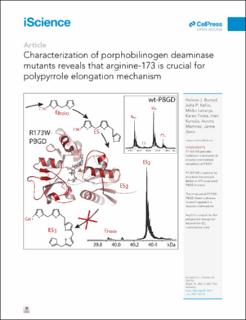| dc.contributor.author | Bustad, Helene J. | |
| dc.contributor.author | Kallio, Juha Pekka | |
| dc.contributor.author | Laitaoja, Mikko | |
| dc.contributor.author | Toska, Karen | |
| dc.contributor.author | Kursula, Inari | |
| dc.contributor.author | Martinez, Aurora | |
| dc.contributor.author | Jänis, Janne | |
| dc.date.accessioned | 2021-08-12T08:05:05Z | |
| dc.date.available | 2021-08-12T08:05:05Z | |
| dc.date.created | 2021-06-16T12:58:30Z | |
| dc.date.issued | 2021 | |
| dc.identifier.issn | 2589-0042 | |
| dc.identifier.uri | https://hdl.handle.net/11250/2767459 | |
| dc.description.abstract | Porphobilinogen deaminase (PBGD), the third enzyme in the heme biosynthesis, catalyzes the sequential coupling of four porphobilinogen (PBG) molecules into a heme precursor. Mutations in PBGD are associated with acute intermittent porphyria (AIP), a rare metabolic disorder. We used Fourier transform ion cyclotron resonance mass spectrometry (FT-ICR MS) to demonstrate that wild-type PBGD and AIP-associated mutant R167W both existed as holoenzymes (Eholo) covalently attached to the dipyrromethane cofactor, and three intermediate complexes, ES, ES2, and ES3, where S represents PBG. In contrast, only ES2 was detected in AIP-associated mutant R173W, indicating that the formation of ES3 is inhibited. The R173W crystal structure in the ES2-state revealed major rearrangements of the loops around the active site, compared to wild-type PBGD in the Eholo-state. These results contribute to elucidating the structural pathogenesis of two common AIP-associated mutations and reveal the important structural role of Arg173 in the polypyrrole elongation mechanism. | en_US |
| dc.language.iso | eng | en_US |
| dc.publisher | Elsevier | en_US |
| dc.rights | Navngivelse 4.0 Internasjonal | * |
| dc.rights.uri | http://creativecommons.org/licenses/by/4.0/deed.no | * |
| dc.title | Characterization of porphobilinogen deaminase mutants reveals that arginine-173 is crucial for polypyrrole elongation mechanism | en_US |
| dc.type | Journal article | en_US |
| dc.type | Peer reviewed | en_US |
| dc.description.version | publishedVersion | en_US |
| dc.rights.holder | Copyright 2021 The Author(s) | en_US |
| dc.source.articlenumber | 102152 | en_US |
| cristin.ispublished | true | |
| cristin.fulltext | original | |
| cristin.qualitycode | 1 | |
| dc.identifier.doi | 10.1016/j.isci.2021.102152 | |
| dc.identifier.cristin | 1916150 | |
| dc.source.journal | iScience | en_US |
| dc.identifier.citation | iScience. 2021, 24 (3), 102152. | en_US |
| dc.source.volume | 24 | en_US |
| dc.source.issue | 3 | en_US |

